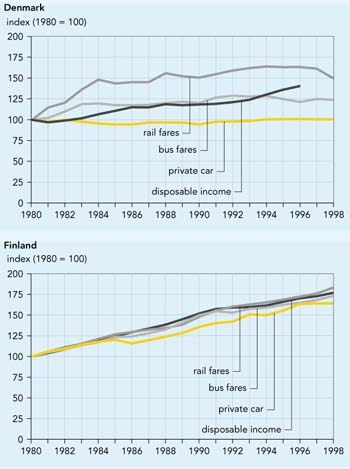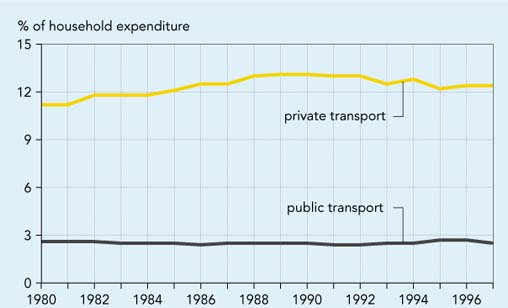Indicator 14 (and 18): Transport price
|
Current prices encourage the use of the private car rather than public
transport. Car transport is much cheaper relative to disposable income
and public transport than it was 20 years ago.
Figure 5.2: Real changes in the price of transport, Denmark and
Finland

Sources: Statistics Denmark; Department of the Environment, Statistics
Finland; Eurostat
Objective
Fair and efficient pricing across modes
Definition
Real change in the price of public transport
fares and the private costs of car use in comparison with the growth in
real personal disposable income.
The costs of car use include all those that the motorist bears directly
(i.e. purchase, maintenance, petrol, oil, tax, and insurance).
|
Policy and targets
Pricing is a key policy tool for promoting an environment-friendly
balance between transport modes and for managing transport demand. Because the
environmental effects of transport vary across modes for example, air and
road generally have greater environmental impacts than rail and shipping (EEA,
1995) prices should be differentiated accordingly.
Community legislation provides for differentiated motor
fuel and freight road-use prices. Tax differentials on motor fuels aim at promoting
cleaner fuels, and variable annual road charges (through the Eurovignette
Directive (CEC, 1998b)) are higher for the heaviest and most polluting lorries.
Some Member States (Austria, Denmark, Germany and Sweden) have different tax
levels for motor vehicles depending on fuel consumption or air pollution performance
(ECMT, 1999 draft).
However, price changes are only one factor affecting
the growth in road traffic: convenience, comfort and security also have a strong
influence on individual decisions on whether and how to travel.
Findings
Data is only available for Denmark, the United Kingdom
and Finland. Changes in relative prices for these countries are shown in Figures
5.1 and 5.2.
In both the UK and Denmark, the costs of private car
transport have remained stable in real terms whilst bus and rail fares have
increased. In the UK, bus and rail fares have risen by less than disposable
income, whereas in Denmark, bus fares have risen by more than, and rail fares
by about the same as, disposable income. In both countries price incentives
have shifted markedly towards car use.
The situation in Finland is rather different to that
in the United Kingdom and Denmark, and probably in other EU countries. General
tax increases in transport as well as the yearly vehicle tax (planned as an
interim measure) were introduced in the early 1990s to cover a state budget
deficit resulting from the recession. This affected private transport (but not
public fares), thereby increasing its price. This, together with the privatisation
of public transport in the largest cities, has increased the competitiveness
of public transport prices. However, even here the rise in the price of car
use has remained below that of public transport since 1986, so again incentives
have shifted towards car use.
|
Box 5.1: Expenditure for personal mobility
The proportion of household expenditure on transport reflects changes
in income and consequent changes in lifestyle, as well as price increases.
Household expenditure on transport is dominated by the purchase and operation
of private cars, and amounted to about 12 % of total expenditure
in 1996 (EU average). Such expenditure increased in the 1980s, but declined
again in the 1990s. Household expenditure on public transport was less
than 3 % in 1996 and has been more or less constant since the 1980s.
In Belgium there has been little change in the proportion of total household
income devoted to transport. In Denmark, Germany and the United Kingdom,
the proportion has risen, but in France, Ireland and the Netherlands it
has fallen. Greece and Portugal have also seen increases in the share
of expenditure on transport because of increased vehicle purchase. Car
ownership has the fastest EU growth rate in these two countries.
It is the intention in future to develop this sub-indicator into a TERM
indicator. This will however require the breakdown of expenditure according
to various income groups. This data is currently lacking.
Figure 5.3: Household expenditure on transport as share of total expenditure

Source: Eurostat
|
Future work
- Since 1995 Eurostat has collected harmonised monthly
consumer price indices (CPIs) for passenger transport, and it is planned that
EU-wide CPIs comparable to the UK and Denmark examples will be available from
Eurostat in the mid-term.
- Similar data showing absolute rather than relative
price levels would help to present overall EU figures for changes in transport
price. There will however, be problems of aggregation, relating to differences
in purchasing power and transport demand between Member States.
|
Data
Real changes in the price of passenger transport (United Kingdom)
Unit: index (base year 1980)
|
|
Year
|
Bus fares
|
Rail fares
|
Private car
|
Disposable income
|
|
1980
|
100.0
|
100.0
|
100.0
|
100.0
|
|
1981
|
98.9
|
102.2
|
101.1
|
99.5
|
|
1982
|
105.0
|
108.0
|
98.3
|
99.2
|
|
1983
|
106.1
|
109.5
|
100.4
|
101.7
|
|
1984
|
103.2
|
104.8
|
98.0
|
105.3
|
|
1985
|
101.5
|
105.0
|
96.7
|
108.9
|
|
1986
|
106.5
|
108.4
|
92.1
|
113.6
|
|
1987
|
108.2
|
109.5
|
93.7
|
117.5
|
|
1988
|
110.3
|
111.6
|
93.3
|
123.7
|
|
1989
|
110.4
|
113.0
|
91.4
|
129.1
|
|
1990
|
106.4
|
112.2
|
88.5
|
133.9
|
|
1991
|
114.6
|
117.1
|
89.8
|
135.9
|
|
1992
|
118.3
|
121.1
|
92.4
|
140.9
|
|
1993
|
121.5
|
127.6
|
95.0
|
145.1
|
|
1994
|
121.7
|
130.1
|
95.8
|
147.0
|
|
1995
|
122.0
|
131.3
|
94.4
|
150.9
|
|
1996
|
123.5
|
133.0
|
94.9
|
154.1
|
|
1997
|
124.1
|
132.0
|
96.9
|
160.0
|
|
1998
|
124.0
|
133.0
|
96.7
|
160.1
|
| Source:
Department of the Environment, Transport and the Regions (United Kingdom) |
|
Data
Real changes in the price of passenger transport
(Denmark)
Unit: index (base year 1980)
|
|
Year
|
Bus fares
|
Rail fares
|
Private car
|
Disposable income
|
|
1980
|
100.0
|
100
|
100.0
|
100.0
|
|
1981
|
114.6
|
105.7
|
97.5
|
97.1
|
|
1982
|
120.3
|
111
|
99.7
|
99.2
|
|
1983
|
136.1
|
115.3
|
97.5
|
101.9
|
|
1984
|
148.1
|
121.1
|
95.5
|
106.8
|
|
1985
|
143.4
|
126.6
|
94.3
|
110.9
|
|
1986
|
145.0
|
129.5
|
94.2
|
115.2
|
|
1987
|
145.1
|
132.3
|
96.8
|
115.0
|
|
1988
|
155.8
|
134.2
|
96.7
|
118.9
|
|
1989
|
152.1
|
138.3
|
96.6
|
117.7
|
|
1990
|
150.5
|
147.8
|
94.3
|
118.5
|
|
1991
|
154.7
|
155.3
|
97.4
|
119.3
|
|
1992
|
159.0
|
160.2
|
97.9
|
121.3
|
|
1993
|
161.9
|
162.7
|
98.4
|
124.1
|
|
1994
|
163.9
|
165.3
|
100.3
|
130.3
|
|
1995
|
163.1
|
168.6
|
100.6
|
136.2
|
|
1996
|
163.2
|
172.3
|
100.8
|
140.6
|
|
1997
|
161.2
|
176
|
100.4
|
-
|
|
1998
|
150.1
|
182.7
|
100.4
|
-
|
| Source:
Statistics Denmark (transport prices), Eurostat (disposable income) |
|
Data
Real changes in the price of passenger transport (Finland)
Unit: index (base year 1980)
|
|
|
Bus fare
|
Rail fares
|
Private car
|
Disposable income
|
|
1980
|
100
|
100
|
100
|
100
|
|
1981
|
104.7
|
105.7
|
106.1
|
103.9
|
|
1982
|
108.5
|
111
|
109.2
|
108.4
|
|
1983
|
113.5
|
115.3
|
114.2
|
113.8
|
|
1984
|
117.1
|
121.1
|
117.6
|
118.8
|
|
1985
|
123.4
|
126.6
|
120.1
|
124.3
|
|
1986
|
124.1
|
129.5
|
115.7
|
129.2
|
|
1987
|
127.9
|
132.3
|
119.5
|
133.6
|
|
1988
|
132.6
|
134.2
|
123.8
|
138.3
|
|
1989
|
140.7
|
138.3
|
128.2
|
144.8
|
|
1990
|
149.7
|
147.8
|
135.5
|
151.8
|
|
1991
|
154.6
|
155.3
|
140.3
|
157.3
|
|
1992
|
152.8
|
160.2
|
142
|
159
|
|
1993
|
157.5
|
162.7
|
150.7
|
159.6
|
|
1994
|
158.9
|
165.3
|
149.8
|
161.6
|
|
1995
|
162.4
|
168.6
|
155.2
|
166
|
|
1996
|
164.8
|
172.3
|
163.4
|
170.2
|
|
1997
|
168.2
|
176
|
164
|
172.7
|
|
1998
|
173
|
182.7
|
164.1
|
176.7
|
| Source:
Statistics Finland |


Document Actions
Share with others